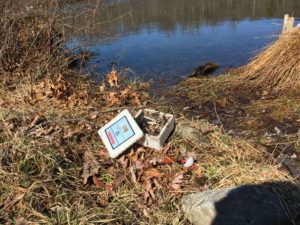Hello Fellow Readers,
Earthworms are destroying forest floors shared William of Bangor PA after I bragged about the benefits of castings (worm poop) in the garden. I didn’t know, along with the benefits of our slimy garden guests, there are negative outcomes of their presence; especially in our woodlands which rely on leaf litter for food and to maintain moisture. Because worms decompose leaf matter quickly and draw nutrients deep into the soil, young plants with shallow roots can be starved of nutrition. Birch, poplar and maples have been largely impacted along with native herbs such as viola, aralia, and botrychium. Meanwhile invasive nonnative plants such as garlic mustard, buckhorn, and stilt grass are taking over as they can survive in the nutrient weakened environment. Sadly, these invasive plants are not eaten by wildlife such as deer.
“How much can a worm poop?” William asked. Earthworms can eat up to the equivalent of their bodyweight each day; converting organic matter into a form that can be easily used by plants. Hence why earthworms, especially those from the Lumbricidae family, are considered good for the garden. Turns out there are only one or two genera of lumbricid earthworms native to North America. Many other nonnative species were introduced by our forefathers when settling here. These fascinating creatures can push ten times their body weight and markedly change the structure of soil. Their presence helps drainage and water retention as they make soil more porous by moving through it. Their burrows are filled with castings that brings surface nutrients belowground which encourages plants to develop deep roots. In the United States, they say there are 50 to more than 300 or earthworms per square yard in croplands and 100 to 500 per square yard in woodlands. That’s a lot of worm poop!
So, what’s good for the garden is not good for the woods. Good thing earthworms are slow moving and we can do our part in limiting their migration by not transporting soil or compost into the woods. Remove invasive species and plant native plants. Don’t dispose of extra fishing worms by releasing them. Avoid transporting plants or unsterilized soil around the country. In fact, consider buying bare-root when mail-order shopping. The red wigglers often used in worm composting bins are not native. Before spreading worm compost, I read you should freeze it for about a week to kill tiny worms and cocoons. Freezing won’t kill the beneficial microorganisms.
It’s hard to imagine these little fellows could also be contributing climate change according to a 2013 study: Lubbers et al. Greenhouse-gas emissions from soils increased by earthworms, Nature Climate Change.
Earthworms Destroy the Planet sounds like a wicked Sci-Fi. Garden Dilemmas? Askmarystone@gmail.com
 After a rain, I’m curious why earthworms are found crossing the road. To get to the other side? Ba-dum-pump :^# :^)
After a rain, I’m curious why earthworms are found crossing the road. To get to the other side? Ba-dum-pump :^# :^)



